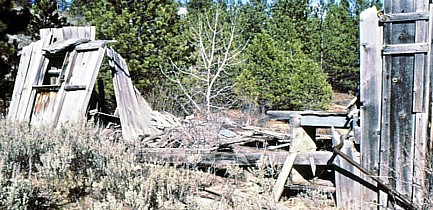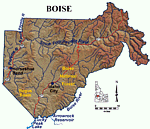Boise Basin Historical Summary
(Excerpts from Boise Basin Visitor & Tourism Development Plan)
It was with the 1862 gold rush to Boise Basin that the development of the State of Idaho began. The Basin story is well deserving of its place in history. This brief summary only highlights key points of the area history.
The rush was on. Originally, people traveled by steamer up the Columbia River to Umatilla, departing from Umatilla by stage lines, and finally journeying by pack-train to the Boise Basin.
Difficult winters and shortages of food made life treacherous. One year a food riot occurred because the spring supplies from Walla Walla had not arrived.
The Basin population swelled to 25,000. The mining proved extensive and the gold was evenly distributed through out the Basin. Many claimed it was the best mining district we ever saw. The mining laws were considered fair and liberal.
On February 4, 1864, Boise County was established. This same year wagon roads brought the wagon trains, hauled by four, six, eight, or even twelve horses or mules. The saw mill ran continuously with rough lumber building up cities like magic.
In 1863 Idaho City had grown to 6000 people and had 250 places of business. Idaho City assumed the notoriety as being the best mining camp in the Basin and the general rendezvous of miners, speculators, and gamblers. There was plenty of amusement. Streets were thronged with wagons, horses, mule, and cattle. Idaho City also was favored by its never failing water supply.
The basin attracted families as it offered special appeal to those seeking homes. More children and women were in evidence here than in most other mining camps. Two early schools were in operation as well as a lending library. The Basin also believed in and appreciated good government.
The height of the boom lasted from 1863 to 1866. By 1867 many sold out to Chinese miners who were able, through industrious work, to make the mines pay; the 1870 Census lists 1700 Chinese. The rich gold fields were considered "panned out" as most readily worked streams had been worked. Another major factor in the decline was the high loss caused by destructive fires. Fires hit Idaho City in 1865, 1867, 1868 and 1871.
Quartz mining prospered in the 1870s with a number of stamp mills in operation. Dredge mining began in 1898 and continued till the 1950. Unfortunately, much of the lower lying land in the Basin has been disfigured by dredging. Also, camps like Buena Vista located across Elk Creek from Idaho City disappeared through dredging. Fires also continued their rampage, wiping out Quartzberg in 1931.
Fabulous Gold Country
(Excerpts from Idaho City Historical Foundation "Welcome, Visitor" pamphlet)
Inspired by an Indian story of gold that could be scooped up by the handful; a party of prospectors led by George Grimes discovered the fabulously rich area known for the past Century as the Boise Basin in 1862. Located on Grimes Pass is the monument of George Grimes.
Gold was there. So were hardships, heartache and tragedy. Grimes was killed within days of the discovery. The first miners staked large and extensive claims and their first settlement became known as , later changed to Pioneer City and now Pioneerville.
Rivalry between the miners was common, and when a party of prospectors ventured over the divide onto Elk Creek and discovered even richer gold deposits, they kept their find a secret by telling a tale of being chased by huge bears. The gulch they discovered, near the end of Idaho City Main Street even today carries the name of .
The $5,000 in gold which these first miners carried out to civilization started one of the greatest gold rushes the world has ever seen, the richest strike in America. It is estimated that more than $250,000,000 was taken from this area in the two decades following its discovery; greater than the California 49er and of the Klondike in Alaska. It is reported that Gold from the Boise Basin helped to strengthen the Union treasury during the most crucial days of the Civil War, perhaps preserving the United States.
Thousands upon thousands of miners rushed pell-mell into the Boise Basin. Towns sprang up everywhere. There were Beaver, Banner, Granite, Forrest and Summit cities. Buena Vista, Eureka, Pomona and Boston. Pioneerville, Placerville, Centerville and Quartsbury. Clarksville, Graham and Idaho City. Some have vanished completely with even their exact location in doubt; many lie in decaying ruin while others are struggling to preserve the way of life that make the Boise Basin famous.
But of all the communities, Idaho City was said to have been the bawdiest and lustiest of the Boise Basin offspring. A rip-roaring mining town, it became the hub of territorial commerce and almost overnight became the largest metropolis in the Idaho Territory, boasting a population in excess of ten thousand for more than two decades.
Idaho City was the birthplace of the Vigilante movement that later swept like wildfire throughout the west. Here it is said the Rev. Charles Kingsley, whose home still stands on Wall Street, instigated the self-styled law of the Vigilantes that brought a semblance of law and order to the West.
Two major fires have swept the town. In 1865 and again in 1867, fire destroyed over 300 buildings with losses estimated at over a million dollars. However, some of the best examples of early day brick work and wooden architecture still exist in Idaho City. Many buildings erected in the 1860 and costing between $15,000 and $30,000 are still standing.
Idaho City was one of the leading cities between Denver and the Pacific Coast, attracting such top entertainment as the Dan Rice Circus (world largest at the time) and the nation top stage and opera stars who played at the community five theaters.
Life was not all culture in the Basin early days. Other entertainment attracted a rougher element as attested by one account which appeared in the "Several parties were found in the streets on Tuesday morning. Some with fractured skulls; some with bunged eyes and swollen faces, indicating very clearly that there had been a muss somewhere during the night. Blood was freely sprinkled about the town on woodpiles and sidewalks. As the puddles of blood were distributed over a large district, it was impossible to locate the fight."

|
 |
Copyright 1996-2024 The USGenWeb Project, IDGenWeb, Boise County

